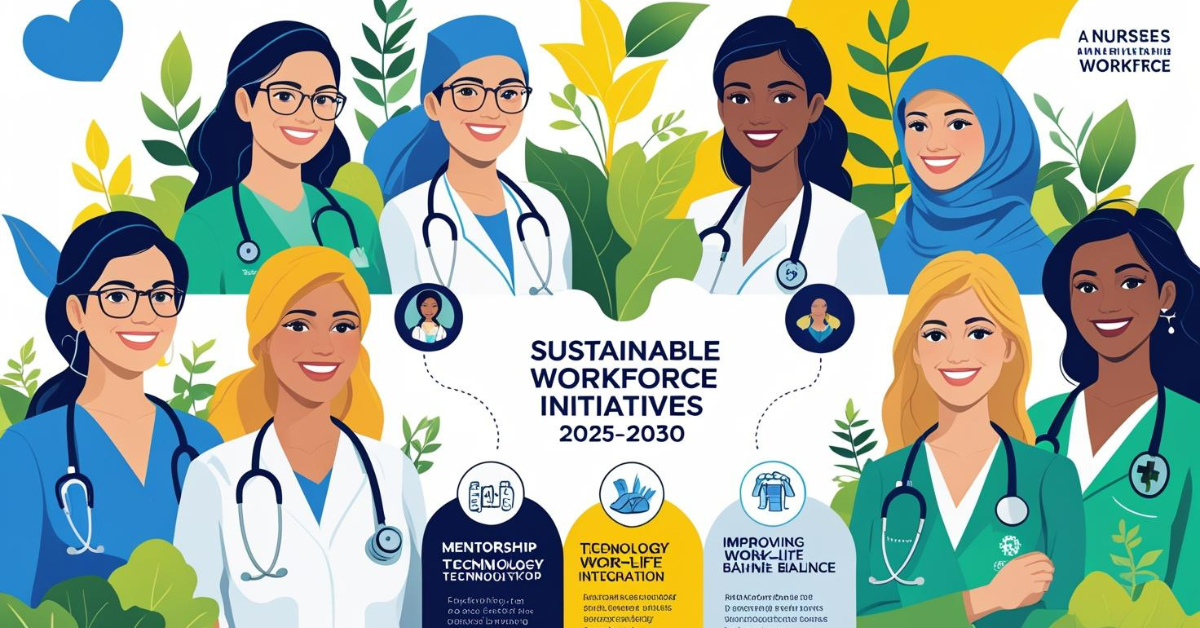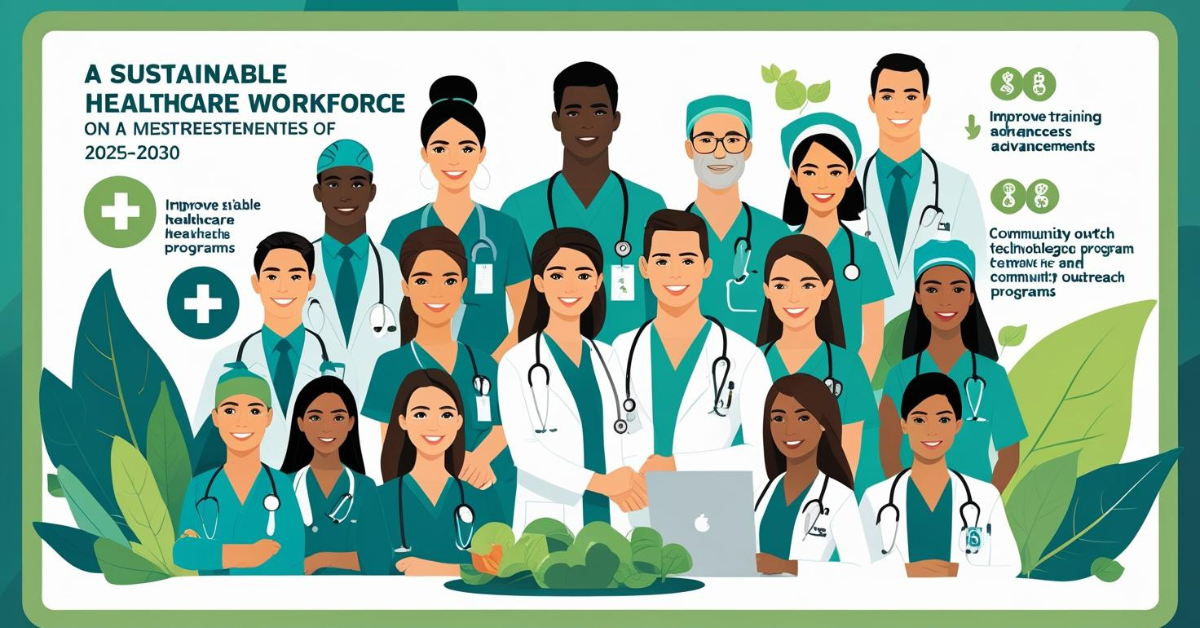The Creating Sustainable Workforce In Nursing and Healthcare for 2025-2030. This requires addressing issues such as staffing and funding shortages, and the impact of social determinants of health on workforce capacity.
How Creating Sustainable Workforce In Nursing and Healthcare for 2025-2030
To build sustainable health and long-term care between 2025 and 2030, strategies must be designed to increase the number of professionals, improve their skills and well-being, and ensure equitable distribution, especially in underserved areas.
Creating and Managing a Sustainable Workforce
The nursing shortage is forecast to continue indefinitely as more nurses retire and as the need for health care increases, particularly because of aging baby boomers. It is estimated that 1.13 million registered nurses (RNs) will be needed by 2022 to fill new jobs and replace retiring nurses (American Nurses Association [ANA], 2014). Several reasons for the ongoing nursing shortage are nursing job dissatisfaction, unhealthy work environments, lack of recognition for accomplishments, and unclear role expectations (Bryant-Hampton, Walton, Carroll, & Strickler, 2010; Masters, 2014; Riley, Rolband, James, & Norton, 2009).
The continuing nursing shortage, high turnover in nursing, complex health-care systems, increasing patient acuity, and fiscal constraints may influence nurse leaders and managers who are eager to fill nursing positions to make quick and sometimes hasty hiring decisions. However, nurse leaders and managers have a responsibility to hire safe, competent nurses with high integrity (Hader, 2005). Recruiting, developing, and retaining quality staff must be a priority for all nurse leaders and managers.
In addition, addressing areas of dissatisfaction to retain experienced nurses is critical to provide the level of complex care needed today. To retain nurses, nurse leaders and managers must establish a healthy work environment that creates joy and meaning at work, creates synergy, and fosters workforce sustainability (American Association of Critical-Care Nurses, 2005; Lucian Leape Institute, 2013).
In this topic, the nurse leader and manager’s role in creating a sustainable workforce is covered, from the recruiting stage through retaining quality nurses. In addition, management of staff is discussed, including the performance review process and corrective action. Knowledge, skills, and attitudes related to the following core-competences are included in this post: teamwork and collaboration.
Creating A Sustainable Workforce for 2025-2030
It is estimated that more than 1 million RNs will reach retirement age between 2025 and 2030 (Health Resources and Service Administration [HRSA] Bureau of Health Professions, 2013). In 2000, many RNs were 41 to 45 years old. Those nurses are now reaching retirement age, yet the smallest numbers of RNs today are 35 to 45 years old, and there has been only a marginal increase in the number of RNs less than 35 years old (HRSA Bureau of Health Professions, 2013).
To maintain a higher percentage of experienced nurses at the bedside, nurse leaders and managers must identify methods to increase nurse satisfaction and explore creative strategies to accommodate older nurses. Nurse leaders and managers also need to bring younger nurses into the workforce to prepare for the retirement of older nurses. To achieve the goal of creating a sustainable workforce, nurse managers and leaders must be able to recruit, interview, orient, and retain quality nurses of all ages.
Recruiting
The cost of recruiting and orienting new nurses requires nurse leaders and managers to make hiring decisions carefully and to seek and select the best person for the right position. Based on the complexity of health care and high acuity of patients, some health-care organizations prefer to hire experienced nurses and/or nurses with baccalaureate degrees or advanced education. However, nurse leaders and managers should consider recruiting and hiring a balance of new nurse graduates and experienced nurses, given the increasing demand for health care, aging baby boomers, and upcoming nurse retirements (McMenamin, 2014).
Nurse leaders and managers must be committed to recruiting and hiring the brightest and the best. By employing new nurse graduates and providing adequate transition-to-practice (TTP) programs, nurse leaders and managers can develop and retain increasingly experienced nurses in anticipation of the retirement of aging nurses—essentially, “growing their own” experienced nursing workforce (McMenamin, 2014). Attracting talented nurses requires providing continuing education, up-to-date technology, professional development, and opportunities for advancement (Roussel, 2013).
Interviewing
Once a quality applicant is identified, the nurse leader and manager should prepare for interviews by reviewing the applicant’s information, resume, and letters of reference and by making notes of key questions to ask during the interview. The interview should be scheduled when the nurse’s leader and manager is available to meet for an adequate amount of time and without interruption; in addition, it is important to ensure that there is ample time for the applicant to ask questions.
Some organizations may use a team approach to interviews in which applicants are also interviewed by a panel of nurses and other staff members. Involving staff can be an effective approach and reduce bias on the part of the nurse leader and manager. The focus of the interviews should be on the roles and responsibilities outlined in the position description. A position description reflects current practice standards and provides clear, written expectations about the roles and responsibilities of the position.
It should also include the name of the person to whom the employee reports. Nurse leaders and managers must treat all applicants equally and as professionals, as well as keeping in mind that applicants may have other positions they are considering. During the interview, the nurse’s leader and manager must avoid asking questions that are considered inappropriate.
Although information related to the applicant’s age, marital status, and medical information may be needed for pay roll, benefits, and insurance purposes, the nurse leader and manager should not inquire about this information during the interview. Such information can be obtained after the employee is hired. T When the nurse leader and manager interview several applicants for the same position, it is important to ask all applicants the same questions. The interview is a two-way process.
While the nurse leader and manager are interviewing applicants to determine whether they are qualified to fill a specific position, applicants should be assessing the interaction and gathering as much information as possible to be able to make an informed decision to accept or decline an offer. A wise applicant researches the organization before the interview. Reviewing the mission, vision, and philosophy of the organization can help nurses deter mine whether the organization’s values and beliefs are congruent with their individual beliefs.
Orienting
Nurse leaders and managers must provide a proper orientation for new staff to enhance retention. When the cost of recruiting and orienting new staff is calculated, the estimated average cost of turnover is equivalent to a nurse’s annual salary (Halfer, 2007). In addition, approximately 25% of new graduate nurses will leave their position within the first year (National Council of State Boards of Nursing [NCSBN], 2015).
To retain new graduate nurses, orientation programs need to bridge the gap between the student nurse clinical setting and the real-world clinical setting. Programs for new nurses that focus on effective TTP and that include both competency development and role transition have been shown to improve retention rates (Halfer, 2007; Spector et al., 2015). The NCSBN (2015) explored the issue of educating and retaining new nurse graduates since 2005 and found that the inability of new nurse graduates to transition into clinical practice has and will continue to have great consequences for the nursing profession and patient outcomes.
In collaboration with more than 35 nursing organizations, the NCSBN worked to develop an evidence-based TTP model to assist new nurses as they transition from the classroom to the clinical setting (NCSBN, 2015); more information about the TTP model is available on the NCSBN Web site at www.ncsbn.org/transition-to-practice.htm. Structured TTP programs that are at least 6 months long and include core competencies, clinical reasoning, regular feedback on progress, self-reflection, and specialty knowledge in an area of practice improve the quality and safety practice of new graduate nurses, increase job satisfaction, decrease stress, and decrease turnover (Spector et al., 2015).
When setting up orientation for new nurses as well as seasoned nurses, the nurse leader and manager must consider the characteristics of the new staff members and select an appropriate preceptor. The novice-to-expert model can assist with making successful preceptor assignments (Benner, 1984). Most new graduate nurses exhibit characteristics of the novice and advanced beginner stage, and new nurse graduates demonstrate marginally acceptable performance (NCSBN, 2011). In many cases, new nurse graduates use context-free rules to guide their actions or may begin to formulate some guidelines for their actions.
New nurse graduates have not developed enough insight to discern which tasks are relevant in real-world situations (NCSBN, 2011). The appropriate preceptor is critical to successful on-boarding of new nurses. Novices and advanced beginners do not have past experiences to base decisions on, so their approach to patient care is slow and methodical; they are very focused on being safe and efficient (Benner, 1984). In addition, the new generation of nurses needs regular verbal and written feedback to build confidence and self-esteem.
The best preceptor for the new graduate nurse may be a nurse who is in the competent stage (i.e., has about 3 years of experience and is able to demonstrate effective organizational, time management, and planning abilities). Competent nurses can differentiate important tasks from less important aspects of care. In addition, their time as a new nurse graduate is recent enough that they can approach the preceptorship with empathy.
A less-than-ideal preceptor is an expert and proficient nurse because nurses at this stage make rapid decisions based on previous experiences, have difficulty putting what they know into words for the new nurse to understand, and may have less patience for the ongoing feedback the new nurse graduate requires (Benner, 1984). On its Web site, the NCSBN provides a chart to assist nurse leaders and managers in assigning preceptors to new nurses.
Retaining
Examining strategies to retain experienced nurses is critical in finding a solution to the long-term nursing shortage. Inadequate staffing leads to nurse dissatisfaction, burnout, and turnover, all of which jeopardizes the quality of patient care. High turnover can have negative consequences for patient safety, nurse satisfaction, and health-care organization overall because of low staff morale, insufficient
monitoring of patients, increased errors, poor-quality care, increased patient costs, and decrease in hospital profitability (American Association of Critical-Care Nurses, 2016; Page, 2004). Moreover, high turnover threatens the overall experience level of the nursing staff, which, in turn, compromises patient safety (Page, 2004). The number one strategy to retain nurses is by creating and sustaining a healthy work environment. Accomplishing this requires strong nursing leadership at all levels of the health-care organization, but especially at the unit level, where front line nurses and nurse leaders and managers work and where patient care is delivered (Sherman & Pross, 2010).
Nurse leaders and managers must create a vision for a healthy work environment and authentically live it (American Association of Critical-Care Nurses, 2005). A healthy work environment is one in which nurses feel safe from physiological and psychological harm and can find meaning and joy in their work. Nurse leaders and managers are responsible for creating the cultural norms and environment that result in workforce safety, meaning, and joy (Lucian Leape Institute, 2013). A work environment can be considered healthy and as one that brings meaning and joy to the worker’s life when each nurse is able to answer “yes” every day to the following questions (Lucian Leape Institute, 2013, p. 15):
- Am I treated with dignity and respect by everyone?
- Do I have what I need so I can contribute that gives meaning to my life?
- Am I recognized and thanked for what I do?
Meaningful recognition is important in retaining experienced nurses. “Nurses must be recognized and must recognize others for the value each brings to work of the organization” (American Association of Critical-Care Nurses, 2016, p. 29). Nurses who are not recognized often feel invisible, undervalued, and disrespected, feelings that eventually can sap their motivation (American Association of Critical Care Nurses, 2016). Nurse leaders and managers have an ethical responsibility to “establish, maintain, and promote conditions of employment that enable nurses to practice according to accepted standards” (ANA, 2015a, p. 28).
Nurse leaders and managers can provide recognition, mentoring, coaching, and career or professional development opportunities to enhance the nursing workforce. Retaining experienced nurses is critical to providing safe and quality care, and a healthy work environment is paramount to retaining experienced nurses.
Related Post:
https://nurseseducator.com/managing-sustainable-workforce-in-nursing-and-healthcare-in-2025-2030/
Read More:
https://nurseseducator.com/didactic-and-dialectic-teaching-rationale-for-team-based-learning/
https://nurseseducator.com/high-fidelity-simulation-use-in-nursing-education/
First NCLEX Exam Center In Pakistan From Lahore (Mall of Lahore) to the Global Nursing
Categories of Journals: W, X, Y and Z Category Journal In Nursing Education
AI in Healthcare Content Creation: A Double-Edged Sword and Scary
Social Links:
https://www.facebook.com/nurseseducator/
https://www.instagram.com/nurseseducator/
https://www.pinterest.com/NursesEducator/
https://www.linkedin.com/in/nurseseducator/
https://www.researchgate.net/profile/Afza-Lal-Din
https://scholar.google.com/citations?hl=en&user=F0XY9vQAAAAJ



Greetings to all betting fans!
The streamlined 1xbet registration nigeria form only asks for essential details. Nigerian players love the simplicity and speed of account creation. [url=п»їhttps://1xbetregistrationinnigeria.com/]1xbetregistrationinnigeria.com[/url] After finishing the 1xbet registration nigeria, a welcome pack with bonuses is automatically applied.
1xbet registration by phone number nigeria lets users bypass long email verification processes. It’s especially convenient for users with limited internet access. With 1xbet registration by phone number nigeria, you can start betting in under 60 seconds.
Access betting via 1xbet nigeria login registration app – http://www.1xbetregistrationinnigeria.com/
Hope you enjoy amazing payouts !
Greetings to all betting fans!
Get started with 1xbet ng registration using your BVN for instant verification. This method helps Nigerian users complete KYC in one step. 1xbet registration nigeria After 1xbet ng registration, you can access both virtual and live betting options.
Sign up with https://1xbetregistrationinnigeria.com/ and get ₦2000 in free bets. Nigerian residents can cash out winnings with zero fees. The https://1xbetregistrationinnigeria.com/ website ensures data safety.
Official betting portal: https://www.1xbetregistrationinnigeria.com/ – https://www.1xbetregistrationinnigeria.com/#
Hope you enjoy amazing spins !
¿Hola seguidores del juego ?
Accessing your account is easy with the 1xbet login registration nigeria method. You simply log in with your phone or email and password. 1xbet nigeria registration online The system is designed for Nigerian users, making it smooth and secure.
Whether you’re into football or slots, the 1xbet nigeria registration unlocks it all. You get access to promos, tournaments, and more. Just sign up and start playing.
1xbetnigeriaregistrationonline.com official signup explained – https://www.1xbetnigeriaregistrationonline.com/
¡Que disfrutes de enormes logros !
I’m gone to say to mmy little brother, that he should also
pay a qick visiit this weblog onn regular bazsis to obtain updated from most recent information. https://hallofgodsinglassi.Wordpress.com/
Today, taking into consideration the fast way of life that everyone leads, credit cards have a big demand in the economy. Persons from every area are using the credit card and people who not using the credit card have made up their minds to apply for just one. Thanks for sharing your ideas about credit cards.
I’d incessantly want to be update on new posts on this web site, bookmarked! .